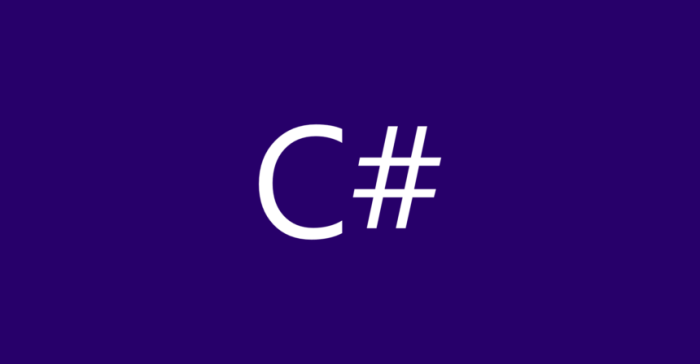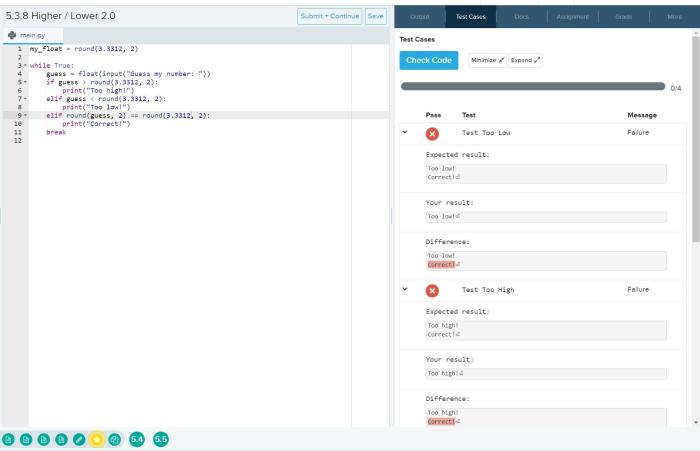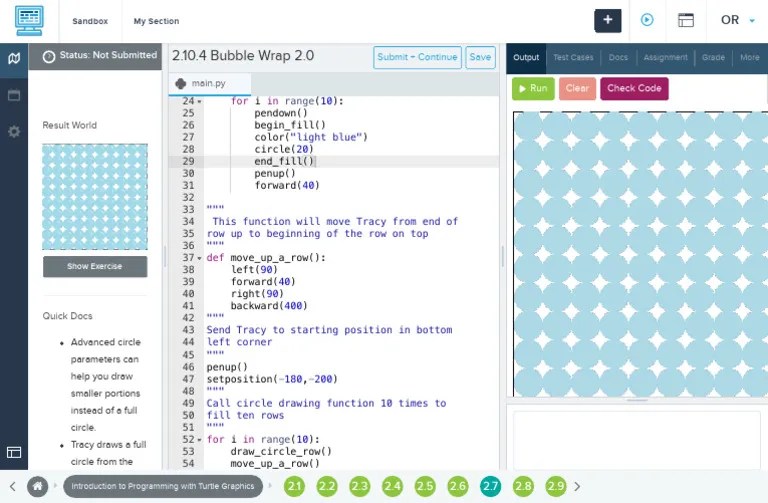Higher / lower 2.0 codehs – Prepare for a thrilling coding adventure with Higher/Lower 2.0 CodeHS, a game that seamlessly blends entertainment and education. Immerse yourself in a captivating gameplay experience that challenges your problem-solving abilities, sharpens your computational thinking, and ignites your passion for coding.
As you progress through the game’s engaging levels, you’ll encounter a plethora of puzzles that test your logical reasoning and critical thinking skills. Each level presents unique challenges, encouraging you to explore innovative algorithms and techniques to find the optimal solution.
Understanding Higher/Lower 2.0 CodeHS
Higher/Lower 2.0 CodeHS is a single-player game that challenges players to predict whether the next number in a sequence will be higher or lower than the previous number. The game consists of 20 levels, each with its own unique set of rules and challenges.
The objective of the game is to correctly predict the next number in the sequence as many times as possible. Players earn points for each correct prediction, and lose points for each incorrect prediction. The game ends when the player reaches the end of the sequence or runs out of points.
Levels and Challenges
The levels in Higher/Lower 2.0 CodeHS become increasingly difficult as the game progresses. In the early levels, the sequences are relatively simple and easy to predict. However, as the game progresses, the sequences become more complex and difficult to predict.
Some of the challenges that players may encounter in Higher/Lower 2.0 CodeHS include:
- Sequences that contain both positive and negative numbers
- Sequences that contain repeating numbers
- Sequences that contain numbers that are very close together
- Sequences that contain numbers that are very far apart
CodeHS Interface and Features
Higher/Lower 2.0 CodeHS presents a user-friendly interface that facilitates a seamless learning experience. The game’s intuitive layout and comprehensive features empower players to navigate the game efficiently and focus on honing their programming skills.
User Interface Overview
Upon launching the game, players are greeted with a clean and organized interface. The main screen comprises a central coding area flanked by a menu bar on the left and a sidebar on the right. The coding area serves as the primary workspace where players write and execute their code.
The menu bar provides access to various options and settings, while the sidebar displays game-related information such as the player’s progress and available challenges.
Menu Bar
The menu bar at the top of the screen houses several important buttons and options. The “File” menu allows players to create new projects, open existing ones, and save their work. The “Edit” menu provides options for editing code, including cut, copy, and paste functionality.
The “View” menu offers settings for customizing the appearance of the coding area, such as changing the font size and theme. The “Help” menu provides access to documentation, tutorials, and other resources to assist players with their programming journey.
Sidebar
The sidebar on the right-hand side of the screen provides a wealth of information to aid players in their coding endeavors. The “Progress” section displays the player’s current level, progress towards completing challenges, and available rewards. The “Challenges” section lists all the challenges available within the game, allowing players to select and attempt challenges at their desired difficulty level.
The “Code Library” section provides a repository of code snippets and examples that players can utilize in their own projects.
Accessibility Features
Higher/Lower 2.0 CodeHS recognizes the importance of accessibility and inclusivity in education. The game offers several accessibility features to cater to diverse learning styles and needs. Players can adjust the font size, color contrast, and keyboard shortcuts to enhance readability and usability.
The game also provides closed captions for videos and audio content, ensuring accessibility for deaf and hard-of-hearing individuals.
Support Resources
CodeHS understands that every learner progresses at their own pace and may require additional support along the way. The game provides a robust support system to assist players with their learning journey. Players can access a comprehensive knowledge base containing articles, tutorials, and frequently asked questions.
Additionally, the CodeHS community forum offers a platform for players to connect with each other, ask questions, and share their experiences.
CodeHS Challenges and Levels

CodeHS Higher/Lower 2.0 offers a structured learning experience through a series of levels and challenges. These levels are designed to progressively introduce and reinforce programming concepts, gradually increasing in difficulty and complexity.
Levels
Higher/Lower 2.0 consists of multiple levels, each focusing on a specific set of programming concepts. These levels are ordered sequentially, with each level building upon the skills learned in the previous ones.
Challenges
Within each level, there are a series of challenges that test your understanding of the concepts covered. These challenges vary in difficulty, with some being relatively straightforward while others require more advanced problem-solving skills.
Scoring System
Each challenge is worth a certain number of points, and your overall score for a level is determined by the total number of points you earn. The scoring system is designed to encourage you to complete challenges correctly and efficiently, as well as to explore different approaches to problem-solving.
Gameplay
Your progress through the levels and challenges is tracked on the CodeHS platform. As you complete challenges and earn points, you will unlock new levels and challenges, allowing you to continue your learning journey and advance your programming skills.
CodeHS Problem-Solving Strategies: Higher / Lower 2.0 Codehs

CodeHS Higher/Lower 2.0 challenges players to engage in critical thinking and logical reasoning. To excel in the game, effective problem-solving strategies are essential. These strategies include:
Algorithms and Techniques, Higher / lower 2.0 codehs
Higher/Lower 2.0 challenges can be solved using a variety of algorithms and techniques. Common approaches include:
- Binary Search:Divide the range of possible solutions in half repeatedly until the correct answer is found.
- Linear Search:Iterate through the range of possible solutions, comparing each one to the target value.
- Brute Force:Try all possible solutions until the correct one is found.
Critical Thinking and Logical Reasoning
Critical thinking and logical reasoning are crucial for success in CodeHS Higher/Lower 2. 0. Players must:
- Analyze the problem:Understand the objective and the constraints of the challenge.
- Identify patterns:Look for relationships between the input and output values.
- Formulate hypotheses:Make educated guesses about the solution based on the patterns observed.
- Test hypotheses:Experiment with different solutions to verify or disprove the hypotheses.
CodeHS Learning Objectives
Higher/Lower 2.0 CodeHS aims to enhance computational thinking and coding proficiency among learners. The game is meticulously designed to align with established coding curricula and standards, ensuring a structured and effective learning experience.
Promoting Computational Thinking
- Higher/Lower 2.0 CodeHS fosters computational thinking by encouraging learners to decompose problems into smaller, manageable steps.
- The game also promotes pattern recognition and algorithmic thinking, enabling learners to identify patterns and develop efficient solutions.
- Furthermore, it emphasizes the importance of logical reasoning and abstraction, helping learners understand the fundamental principles of computer science.
Enhancing Coding Skills
- Higher/Lower 2.0 CodeHS provides a hands-on environment for learners to practice and refine their coding skills.
- The game introduces essential programming concepts such as variables, loops, and conditional statements.
- Through engaging challenges, learners can apply these concepts to solve coding problems and develop their programming proficiency.
Alignment with Coding Curricula and Standards
Higher/Lower 2.0 CodeHS is carefully aligned with widely recognized coding curricula and standards, including the Computer Science Teachers Association (CSTA) K-12 Computer Science Standards and the International Society for Technology in Education (ISTE) Standards for Students.
This alignment ensures that the game’s content and activities are relevant and effective for learners at various educational levels.
CodeHS Visualizations and Data Structures

CodeHS Visualizations and Data Structures play a crucial role in Higher/Lower 2.0. These features enhance the gameplay and learning experience by providing intuitive representations of data and utilizing efficient data structures for efficient data manipulation.
Higher/Lower 2.0 employs a variety of data structures to represent and manipulate data, including arrays, stacks, queues, and linked lists. Arrays are used to store ordered sequences of data, stacks are used to manage data in a last-in-first-out (LIFO) manner, queues are used to manage data in a first-in-first-out (FIFO) manner, and linked lists are used to store data in a flexible and dynamic manner.
Visualizations
CodeHS Visualizations provide a graphical representation of data, making it easier for learners to understand and analyze complex concepts. The game utilizes various visualizations, such as bar charts, line graphs, and scatter plots, to display data in a visually appealing and informative manner.
For instance, the “Data Explorer” feature allows learners to visualize and manipulate data sets using interactive charts and graphs. This helps learners gain insights into the distribution and relationships within data, fostering their understanding of data analysis and interpretation.
For a thorough preparation of higher / lower 2.0 codehs, it is essential to practice various question types. One excellent resource is the apush unit 6 practice mcq collection. By solving these multiple-choice questions, you can enhance your understanding of historical concepts and improve your test-taking skills.
These practice questions will provide you with a solid foundation for tackling higher / lower 2.0 codehs with confidence.
Data Structures
CodeHS Data Structures provide efficient ways to organize and manage data. The game utilizes a range of data structures, each tailored to specific data types and operations. These data structures include:
- Arrays:Arrays are used to store ordered sequences of data, such as a list of numbers or a sequence of characters.
- Stacks:Stacks are used to manage data in a last-in-first-out (LIFO) manner, similar to a stack of plates. This data structure is commonly used for tasks such as function calls and recursion.
- Queues:Queues are used to manage data in a first-in-first-out (FIFO) manner, similar to a queue at a store. This data structure is often used for tasks such as managing waiting lists or job queues.
- Linked Lists:Linked lists are used to store data in a flexible and dynamic manner, where each element is linked to the next. This data structure allows for efficient insertion and deletion of elements.
By utilizing these data structures, CodeHS Higher/Lower 2.0 enhances the learning experience by providing efficient and intuitive ways to represent and manipulate data. This helps learners develop a deeper understanding of data structures and their applications in real-world programming scenarios.
CodeHS Community and Resources

The CodeHS community plays a crucial role in Higher/Lower 2.0 CodeHS, fostering a collaborative and supportive learning environment.
CodeHS offers various forums, tutorials, and support resources to facilitate knowledge sharing and problem-solving. The community actively contributes to the game’s development by providing feedback, suggesting improvements, and creating additional challenges.
Forums
- CodeHS provides dedicated forums where students and educators can connect, ask questions, and engage in discussions.
- These forums offer a platform for seeking assistance from peers and experts, sharing knowledge, and troubleshooting coding challenges.
Tutorials
- CodeHS offers a comprehensive library of tutorials that cover various coding concepts, from beginner to advanced levels.
- These tutorials provide step-by-step guidance, interactive exercises, and code examples to enhance understanding and practical application.
Support Resources
- CodeHS provides extensive documentation, FAQs, and troubleshooting guides to assist users with technical issues or conceptual difficulties.
- Additionally, CodeHS offers email and phone support to address specific inquiries and provide personalized assistance.
FAQ Section
What is the objective of Higher/Lower 2.0 CodeHS?
The objective of the game is to correctly predict whether the next number in a sequence will be higher or lower than the previous number.
What skills can I develop by playing Higher/Lower 2.0 CodeHS?
By playing Higher/Lower 2.0 CodeHS, you can develop problem-solving skills, logical reasoning, computational thinking, and coding proficiency.
Is Higher/Lower 2.0 CodeHS suitable for beginners?
Yes, Higher/Lower 2.0 CodeHS is designed to be accessible and enjoyable for beginners and experienced coders alike.